-
Car Reviews
- All reviews
- Midsize SUVs
- Small cars
- Utes
- Small SUVs
- Large SUVs
- Large cars
- Sports SUVs
- Sports cars
- Vans
Latest reviews
- Car News
-
Car Comparisons
Latest comparisons
- Chasing Deals
A bigger battery means more electric range and less petrol used in Volvo’s biggest plug-in SUV
In theory, the Volvo XC90 Recharge PHEV is the perfect vehicle for 2022. It’s an SUV, it’s crammed with advanced safety tech, and most importantly – it’s a plug-in hybrid electric vehicle, meaning you can drive it entirely as an electric vehicle for most daily driving, keeping ownership costs down at the petrol pump.
In Australia, Volvo’s XC90 range consists of two variants; a mild hybrid petrol B5, and the range-topping T8 PHEV. Pricing starts around $100,000 for the entry-level petrol XC90, at the other end of the spectrum, buyers will be shelling out at least $130,000 for a PHEV.
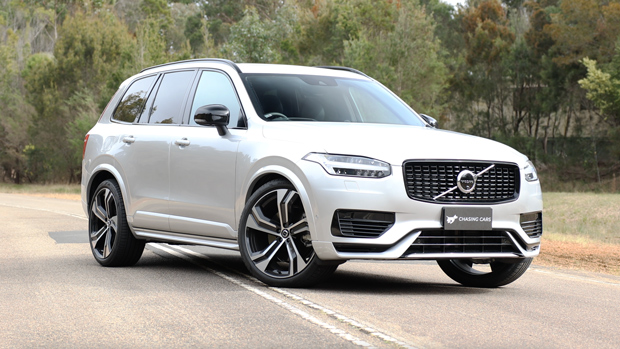
For our time in the XC90, we had a fully loaded Recharge PHEV, which not only benefits from a raft of options as standard, but added heated seats and a heated steering wheel, as well as metallic paint.
Sitting in the space between petrol/diesel-only SUVs and pure electric vehicles, plug-in hybrid crossovers like the XC90 Recharge are sometimes a little cumbersome and weighty in our testing. Sitting at over 2.3-tonnes, the Volvo certainly falls into the latter category, but have the firm’s Swedish engineers done enough to overcome the former?
Just recently, Volvo’s largest plug-in SUV underwent a mild update where it got a bigger battery, meaning that it can drive even further on petrol power alone. This is a massive step in the right direction for the XC90 Recharge, as it’s made the XC90 an even better proposition in both the luxury SUV and electric vehicle space.
Before diving into the schematics of how the XC90 Recharge PHEV handles on the road, it’s worth working out how exactly it works – because it’s rather complicated.
Beneath the bonnet sits a twin-charged 2.0-litre petrol four-cylinder engine – meaning it’s both turbocharged and supercharged. This engine pumps out 233kW and 400Nm, which is sent exclusively to the front wheels through an eight-speed automatic transmission.
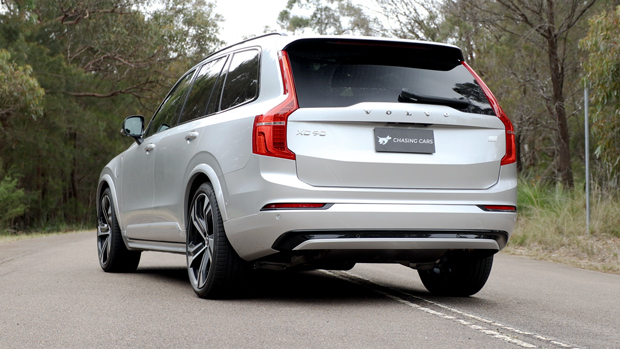
To create the Recharge variant’s all-wheel drive system, an electric motor mounted on the rear axle works to drive the rear wheels. This motor makes 107kW and 309Nm, pushing peak output across both power sources to 340kW and 709Nm. For car buffs, that means the XC90 Recharge is actually rear-wheel drive (RWD) when driven in the ‘Pure’ electric drive mode.
As you’d expect, those burly figures translate to quite a brisk SUV, that will sprint to 100km/h in under six seconds. But while the figure is impressive, planting the boot in the XC90 shows up a crack in the big Volvo’s facade.
Because the all-wheel drive system is combining two independent power units which aren’t delivering torque in a symmetrical manner, the disconnect between front and rear wheels becomes obvious by way of some slip in wet conditions. It’s nothing alarming, but the front wheels seem to struggle for grip and trigger the traction control system, whilst the rear motor attempts to keep up.
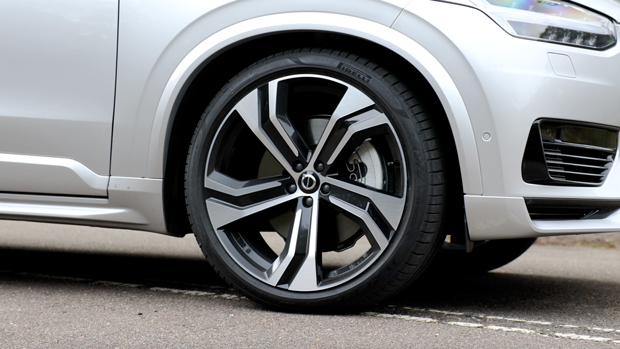
Notably, this problem doesn’t occur in the other, petrol-only versions of the XC90, which use a traditional Haldex-type all-wheel drive system that ferries drive from the engine to the rear wheels via a typical driveshaft.
On the road, the XC90 Recharge PHEV offers an extremely composed ride, but this is something that we’ve come to expect from the brand.
As standard, the hybrid XC90 rides on an air suspension system that’s offered as an optional $3,600 extra on lesser variants – and the air ride is a total no-brainer in my eyes. Not only can the XC90 adjust ride height dependent on the drive mode, but it also soaks up the harshest pot holes that New South Wales can muster up. This is no easy feat considering the 22-inch wheels that the XC90 Recharge rides on as standard.
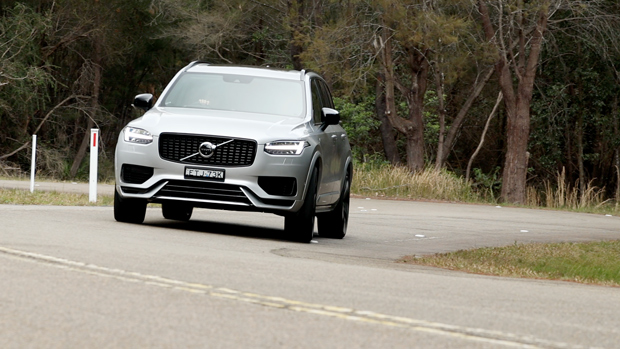
There are very few SUVs on such large wheels that ride as comfortably as this Volvo, letting you have the looks but without the compliance penalty. It’s basically the XC90, and the Range Rover, that accomplish such a feat.
As with most luxury SUVs, the dynamic driving modes heavily dictate how the XC90 handles. Drivers have five to choose from including; Off-road, All-wheel Drive, Power, Pure, and Hybrid. There’s also an Individual mode where drivers can tailor a ride for themselves.
For the most part, drivers will find themselves toggling between the pure electric, and hybrid drive modes to maximise electric power. In the non-performance modes, steering in the XC90 is rather vague, and quite light, along the same lines, the weight behind the SUV is evident, with body roll being obvious through corners.
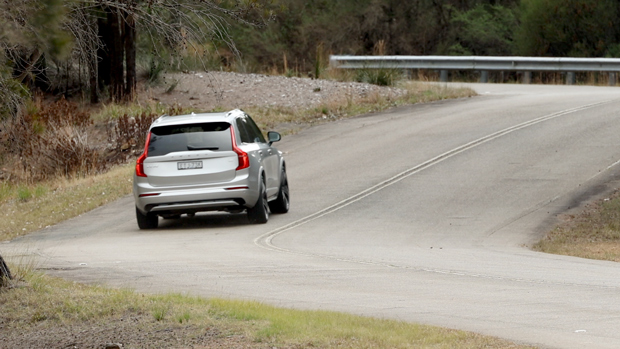
Once ‘Power’ mode is selected, the steering tightens up, and gets more weight to it, which feels a lot more dependable during brisker drives. In this mode, the suspension follows a similar formula, and conveys a lot more road feeling to the cabin.
In terms of safety tech, the XC90 range gets Volvo’s full suite of advanced tech as standard. This includes adaptive cruise control, lane keep assist, blind spot assist, plus a few more.
Unlike some systems which can be overly controlling, Volvo has found a good middle ground here, providing active systems that won’t be overly controlling. Lane keep assist is a perfect example of this, as the steering inputs are subtle, and an audible alarm sounds before leaving the lane completely.
I’d argue that the interior of the XC90 is one of the main selling points. Simple, clean and exceptionally high-quality, the XC90’s cabin is nothing short of spectacular.
Soft touch materials cover the majority of surfaces across the cabin, and is complimented nicely by either aluminum or wood trim – depending on the interior appointment.
It was a consensus across the office that the seats are some of the most comfortable in the market, and the two up front especially offer fantastic support.
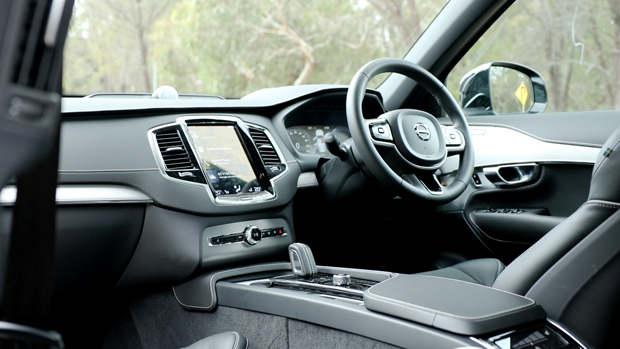
Space is something that the XC90 has always had plenty of, and this latest one is no different. There’s an impressive amount of leg and head space across the first two rows, with the only compromise coming in the middle seat of the second row. Here, battery packaging along the spine of the vehicle means that the middle passenger is left straddling the tunnel.
In the third row, passengers around the six-foot mark will find their knees up against the seat in front, and their head against the roof. Like most seven-seat SUVs, this row is best left for the smaller passengers.
Due to the aforementioned battery packaging around the spine of the vehicle, the Recharge isn’t down on any luggage space compared to the rest of the XC90 range.
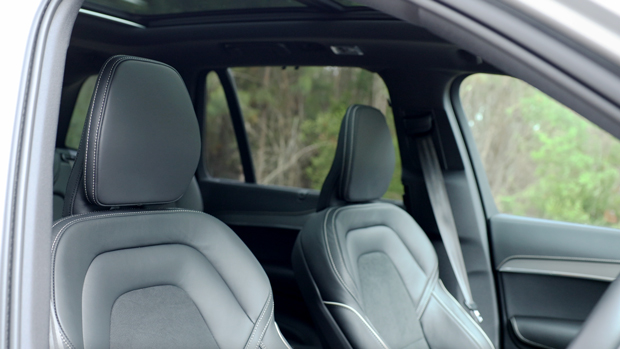
It’s a flat-loading situation across the rear, with both rows having the ability to be folded flat. In terms of sheer space, there’s 397 litres with all three rows in place, 775 litres with the third row folded, and an impressive 1197 litres when both rows are put down.
It’s clear that Volvo was aiming for simplicity with the XC90’s interior, as the portrait-mounted infotainment display takes pride of place in the dash. This screen measures 12.3-inches and is now on the smaller side for the segment, but it gets both wired Apple CarPlay and Android Auto connectivity.
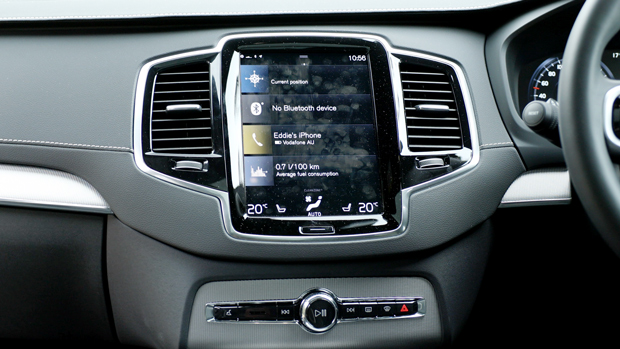
Interestingly, the XC90 still misses out on Volvo’s fantastic Android-powered Google infotainment system, but according to Volvo Australia, this should be implemented on the models landing early next year.
If phone mirroring isn’t your thing, the standard Volvo Sensus operating system is easy enough to use, with its iPad-style layout. Navigation isn’t cloud-updated with traffic information, but it’s a comprehensive mapping system, and the energy flow meter is one of the most comprehensive I have come across. This screen is flanked by a 12-inch digital display cluster that doubles as a visual route guidance when navigation is active.
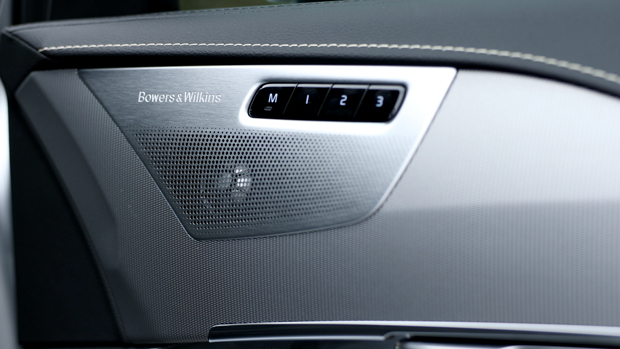
Arguably the most impressive aspect of the XC90’s interior is the Bowers and Wilkins sound system that comes standard in the Recharge PHEV. Across the rest of the XC90 range, this is a $4,350 option, but I’d argue that it’s the most important one to check if you aren’t buying the PHEV. Not only does it get the pre-loaded EQ profiles, but drivers also have access to nine-band equaliser to create a sound profile to their liking.
Volvo claims a fuel usage figure of 1.8L/100km in the Recharge PHEV, but this is not overly representative of a real-world figure as it assumes that drivers will always have the battery topped up.
With a discharged battery, we managed to still pull 6L/100km from the PHEV in hybrid mode, which is an impressive figure for something of this size.
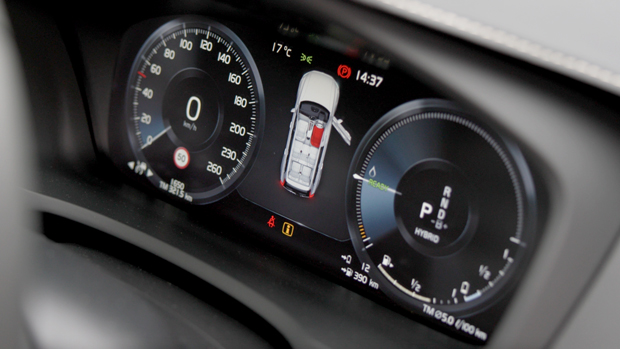
As with all PHEVs, driving with a full battery that slowly discharges over time leaves the XC90 somewhere in the middle of the two, until it hits the dead battery ceiling in that 6L/100km region.
During testing we found that the Volvo will drive up to 60km on pure electric power alone, which is an impressive figure in the PHEV realm. In terms of charging, it will take around seven hours to fill when plugged into a standard three-pin plug, at a rate of 2.2kW.
Fast charging isn’t possible with the XC90, as 3.6kW is the maximum charging rate, so no matter how fast the charger is, it will only ever charge at 3.6kW, with which it will take four hours to fill.
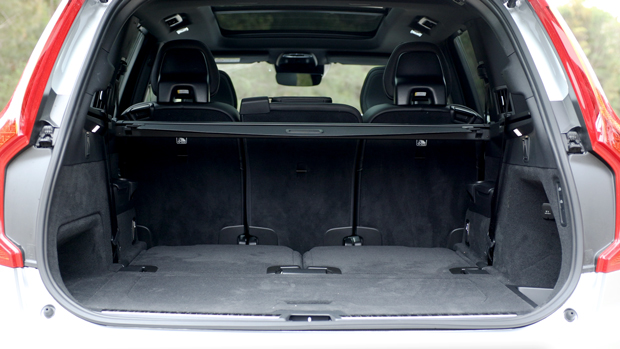
When it comes to keeping this big SUV on the road, Volvo has two service plans to choose from. Three years or 45,000km costs $1750, and five years or 75,000km will set you back $3000. Service intervals are 15,000km, so you’d be looking at spending around $600 each service over a five-year period. Volvo also offers a five year/unlimited kilometre warranty across its range.
In comparison to its closest seven-seat rivals, the XC90 Recharge PHEV’s five-year service plan is a little steeper, but this could be expected due to the fact it’s the only PHEV. BMW will charge you $2,370 for an X7 plan over five years/80,000km, and the Land Rover Discovery will cost a similar amount over five years/130,000km at $2,650.
As a whole, this Volvo XC90 Recharge PHEV feels like one of the best seven-seat SUVs on the market, and on top that, one of the most impressive PHEVs. This large SUV blends performance, style, and comfort together effortlessly, and that’s even before the great economy is brought into the picture.
There’s no getting past the fact that you won’t be getting an XC90 Recharge PHEV on the road for less than $130,000, but there’s a lot of value included in that six-figure price.
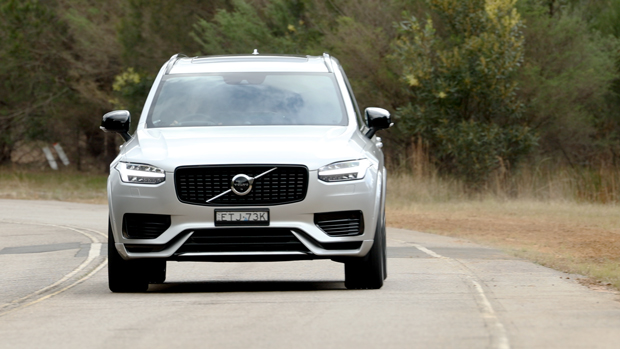
I’d argue that the standard inclusions such as the air suspension and sound system are both things that would be worth choosing on a standard XC90, but here you get those plus the bonus of an incredibly frugal powertrain.
It’s also worth noting that if the plug-in hybrid system and its high price doesn’t appeal, Volvo will sell you an XC90 B5 Pure base model for about $100,000 driveaway – and that car packs 90% of the goodness of the top-of-the-range model.
I can imagine that the likes of Land Rover, BMW, Audi, and Mercedes will be wasting no time in bringing a seven-seat PHEV to Australia, but for now this is the only option, and it’s a fantastic one at that.
Variant tested RECHARGE ULTIMATE T8 PHEV
Key specs (as tested)
About Chasing cars
Chasing Cars reviews are 100% independent.
Because we are powered by Budget Direct Insurance, we don’t receive advertising or sales revenue from car manufacturers.
We’re truly independent – giving you Australia’s best car reviews.
The estimate provided does not take into account your personal circumstances but is intended to give a general indication of the cost of insurance, in order to obtain a complete quote, please visit www.budgetdirect.com.au. Estimate includes 15%^ online discount.
^Conditions Apply
Budget Direct Insurance arranged by Auto & General Services Pty Ltd ACN 003 617 909(AGS) AFSL 241 411, for and on behalf of the insurer, Auto & General Insurance Company Limited(ABN 42 111 586 353, AFSL 285 571).Because we don’t know your financial needs, we can’t advise you if this insurance will suit you. You should consider your needs and the Product Disclosure Statement before making a decision to buy insurance. Terms and conditions apply.
Indicative quote based on assumptions including postcode , 40 year old male with no offences, licence suspensions or claims in the last 5 years, a NCD Rating 1 and no younger drivers listed. White car, driven up to 10,000kms a year, unfinanced, with no modifications, factory options and/or non-standard accessories, private use only and garaged at night.
^Online Discounts Terms & Conditions
1. Discounts apply to the premium paid for a new Budget Direct Gold Comprehensive Car Insurance, Third Party Property Only or Third Party Property, Fire & Theft Insurance policy initiated online on or after 29 March 2017. Discounts do not apply to optional Roadside Assistance.
2. Discounts do not apply to any renewal offer of insurance.
3. Discounts only apply to the insurance portion of the premium. Discounts are applied before government charges, taxes, levies and fees, including instalment processing fees (as applicable). The full extent of discounts may therefore be impacted.
4. We reserve the right to change the offer without notice.